Fashion is taking over hotels – here’s where to stay for a couture summer…

The flamboyance of fashion seems an obvious bedfellow for the hotel trade – the drama, colour and flair of the catwalk transposed into restaurants, bars and bedrooms. As more fashion-world names open destination stays across the world, we delve into their finer couture details.
‘When I went to Parsons School of Design in New York in the late 1970s, I thought I was just going to be a lovely fashion student, have lots of fun and go to parties, but it was the most exacting course,’ remembers the British designer Jasper Conran. Learning the intricacy of couture methods – ‘how to pull the threads on the fabric, how to cut on the bias, how to do tiny, tiny little hand stitches,’ he recalls – taught him ‘to delve into the detail of things, right down into the minutiae of it’.
It’s this intricate focus, the obsessive way a fashion designer might fixate on the imperceptible importance of where a button sits or the way a swathe of fabric falls, that helps them bring the hotel experience to life in unique and intriguing ways. Here, we speak to the maestros behind the continued rise of the fashion-founded hotel…
The Largo, Porto
‘It goes without saying that attention to detail is important in both fashion and hospitality,’ asserts Steen Bock, co-founder with Per Enevlodsen of the new Danish hospitality brand Annassurra, which softly opened The Largo last year in Porto’s Largo de São Domingos neighbourhood. With architecture by Lisbon-based Frederico Valsassina, its Cozinha das Flores and Flôr restaurant and bar (as well as in-house dining) being overseen by leading London/Lisbon chef Nuno Mendes, and interiors designed by Peter Bundgaard Rützou and Signe Bindslev Henriksen of Space Copenhagen, the 18-room hotel, set across five centuries-old buildings, is a place to connect guests, locals, artists and artisans – much as you might when staying in someone’s home.
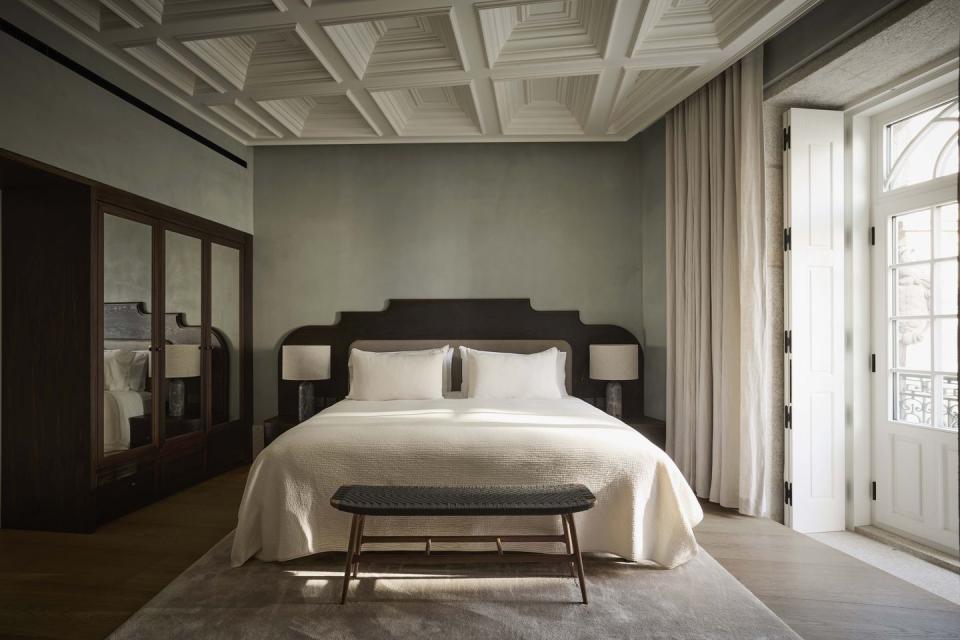
Enevlodsen and Bock, the dynamic driving force behind jewellery brand Pandora’s huge global success, are also avid travel buddies who believe the best journeys involve a meaningful connection between guest and destination. While they might have a visual and aesthetic eye honed from working in fashion, ‘it’s also good to remember how much “experience” plays a huge role,’ notes Bock. ‘The feeling of seeing and trying on a beautiful piece of jewellery or arriving at a beautiful hotel or restaurant draw on very similar instincts within both of us.’
The duo’s move from fashion into hotels has focused on wanting to create spaces where it is ‘more about the people driving the story and the value of a bespoke approach,’ says Bock. At the hotel’s heart is an emphasis on conviviality – the sommeliers will take you on an adventure through the world of Portuguese wine; Mendes might escort you to the local fish and food markets to seek out ingredients for lunch.
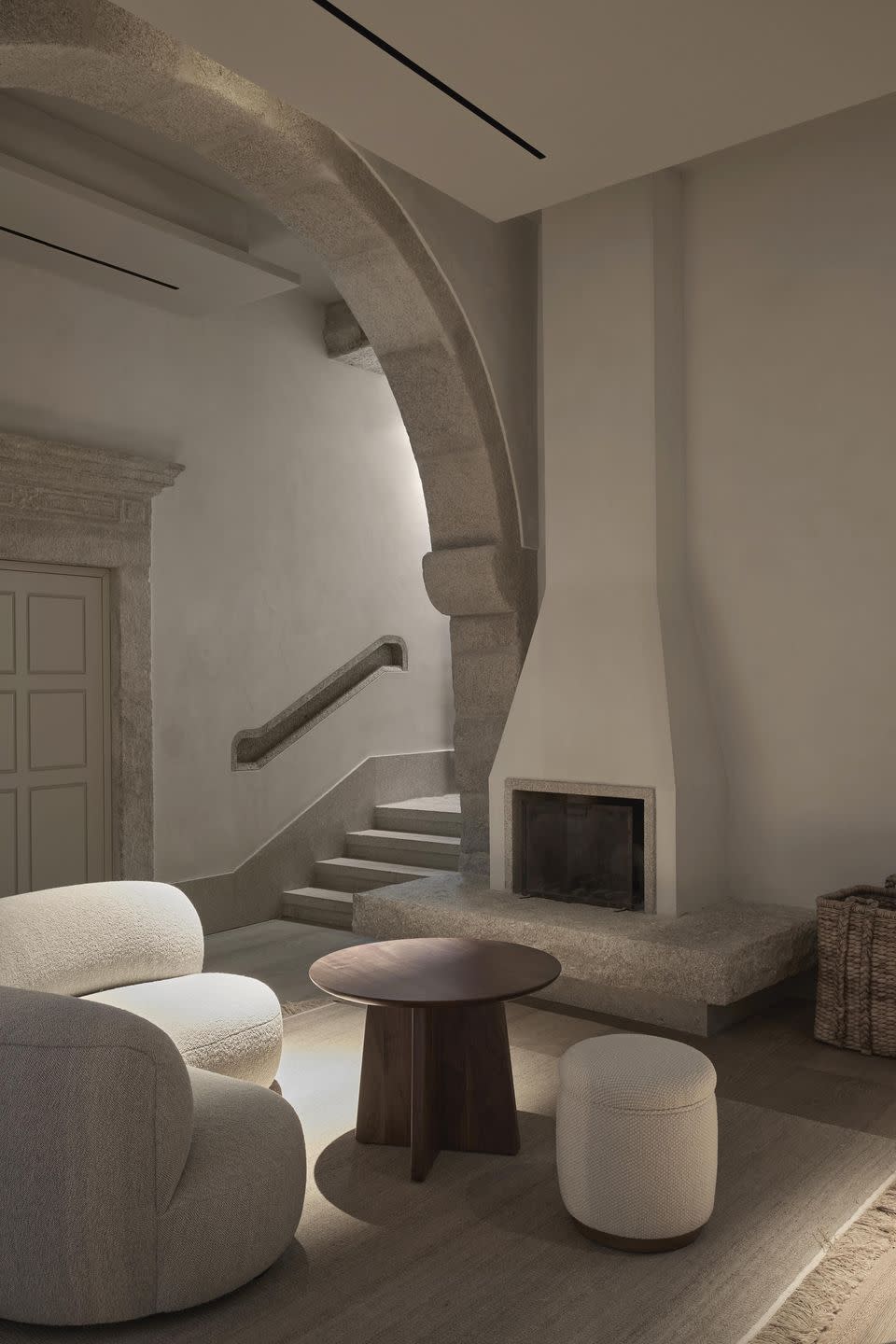
Within Space Copenhagen’s stunning interiors, where restored original details are teamed with the design duo’s penchant for knocked-back hues and clean-lined furniture with a mid-century feel, there is a cool serenity that provides relief from the busy streets and sunshine outside the discreet front door. ‘We wanted to create a soft and charming oasis in the heart of Porto – a place where you can sense the honest, genuine atmosphere of the neighbourhood’s historic buildings; a place to discover and recharge,’ say Bundgaard Rützou and Bindslev Henriksen. thelargo.com
Drei Berge, Switzerland
After 10 years of spending at least 200 nights of the year away from home for work, ‘little by little, you start to know what you want from a hotel,’ says the fashion disruptor-turned-creative polymath and now hotelier Ramdane Touhami. So when it came to creating Drei Berge, a 19-room hotel in the high-altitude Swiss village of Mürren, Touhami knew exactly what he wanted to do.
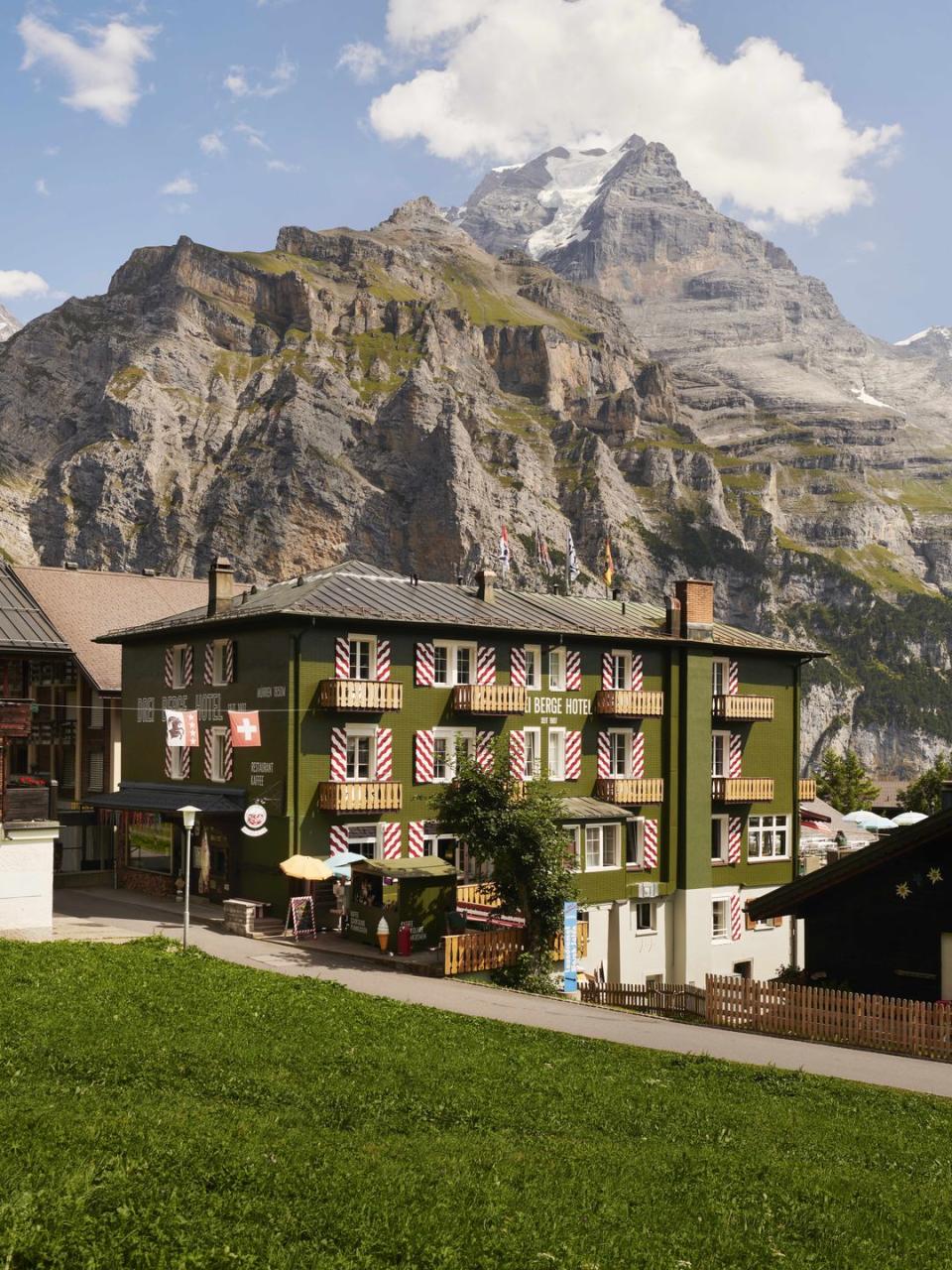
Out went all the annoying details of a corporate hotel – ‘that make me totally mad’ – and in came everything with ‘a feeling of home,’ he says. ‘I wanted a super bed, amazingly soft embroidered sheets and towels, a very good breakfast. I love the idea that you go simply for the hotel because you know you’re going to spend a few days eating well, having fun and reading good books in the library,’ he grins. As a passionate hiker, Touhami was drawn to Mürren, 1,650 metres above sea level and only reached by cable car, for its location nestled on a cliffside, overlooking breathtaking Unesco-protected valleys and the magnificent Jungfrau, Eiger and Mönch peaks. ‘I had been all over the country, looking for 10 years, visiting so many hotels,’ he explains. Here, says Touhami, ‘the air is clear. The water is pure. There are no cars. The only sounds you’ll hear are birds singing and kids playing. At night, you see the stars. Wow! Like you really see the stars.’
Taking over a century-old existing hotel, Touhami has transformed it with a hint of contemporary but slightly crazy chalet chic. ‘My radicalism lies in never taking no for an answer,’ he notes of a 30-year career spanning his early days in fashion – from starting his own streetwear brand as a teen, via concept stores in his twenties, to rebooting Liberty’s menswear department – before reinventing Trudon (the ancient French wax company), designing for Christofle silverware and dreaming up the beauty brand Officine Universelle Buly (Buly 1803 for short) with his wife Victoire de Taillac.
The fashion and beauty world taught Touhami ‘to create a story is more than just creating the clothes or a scented candle. In the end, these things were not that important: the point was everything you imagined around them.’ So at Drei Berge, no detail has missed Touhami’s Midas touch, from the cups and saucers made in Japanese Arita porcelain laid out for breakfast in the morning to the custom scent infusing the air with oaky, mossy notes of pine.
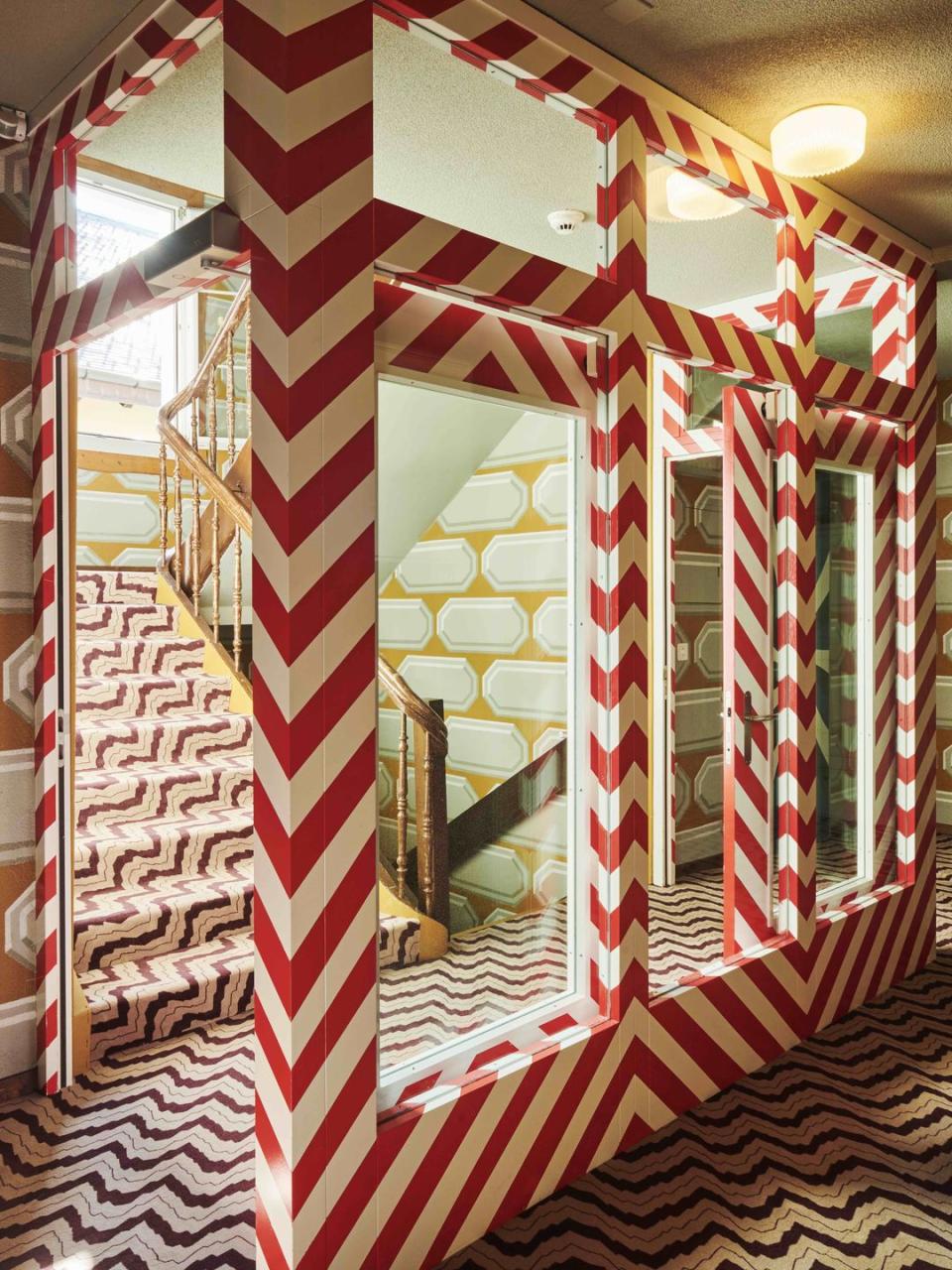
For the interior, think vivid colours (red candy-striped shutters are a graphic intervention against the deep forest-green of the building’s otherwise traditional timber-framed façade), bonkers pattern (the lobby carpet is woven with myriad flags marking the world’s highest summits; curtains are sewn with mountain patches), intricately carved Swiss wood panelling, vintage furniture and lighting (including precious originals by the likes of mid-century design heroes Charlotte Perriand, Martin Visser, Tarcision Colzani and Niek Hiemstra) and unexpected touches like carved wooden Loschentäl carnival masks, retro telephones and 19th-century Tirol paintings.
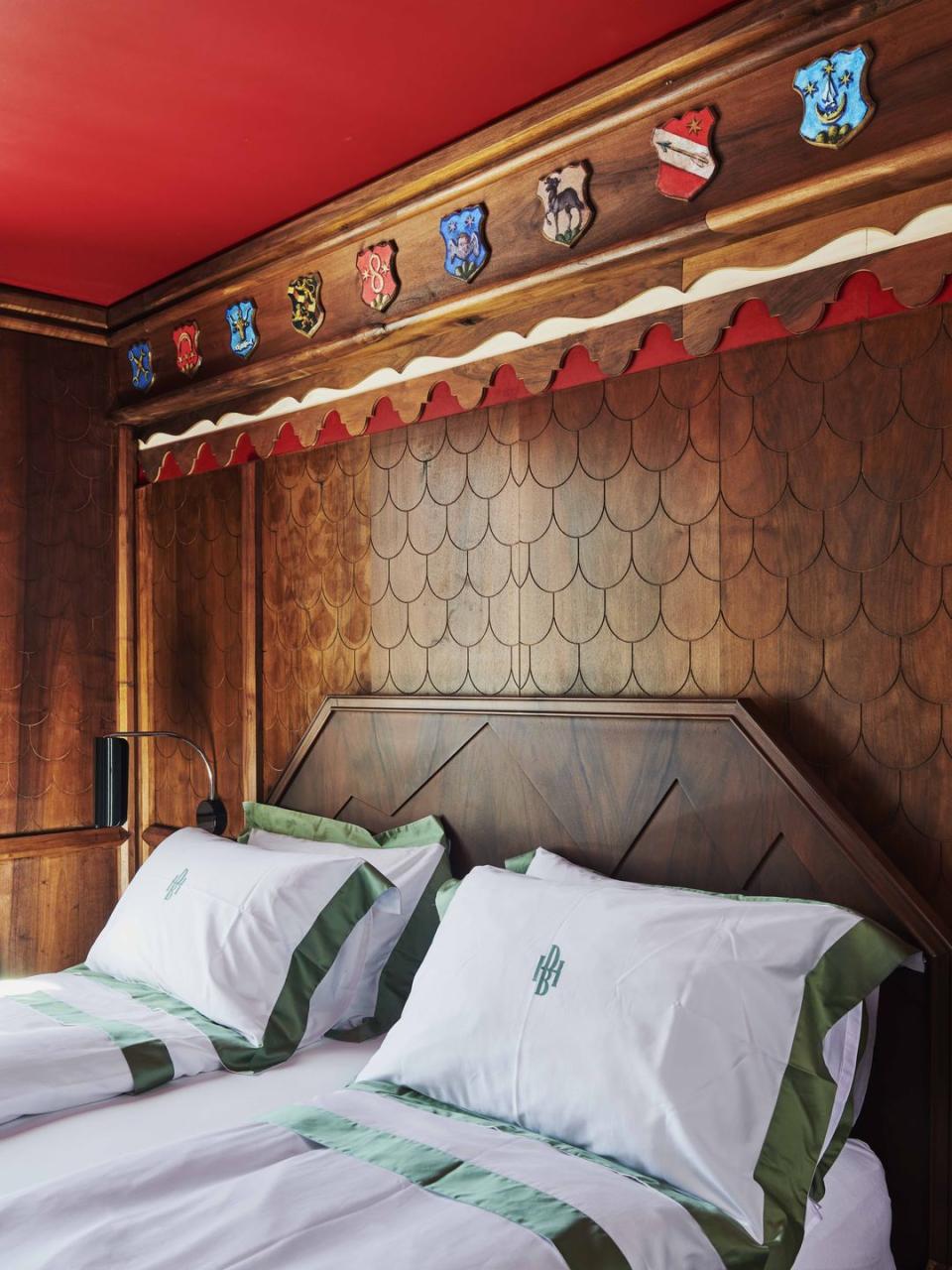
The light-as-air bedding was sourced from Italian linen maker Beltrami (which Touhami loved so much, he invested in the company), while the woollen curtains hanging in every space are now part of the ‘Drei Berge Collection’, made in collaboration with Swiss textile brand Fischbacher 1819 and unveiled at Milan design week. Crafted to accommodate the shifting seasons, the ‘Jungfrau’ knitted curtain suggests a thick woollen jumper; ‘Eiger’ is a soft woven-plain fabric suitable for summery curtains and light upholstery, and then there’s ‘Mönch’, a textured wool and alpaca plaid throw. Curtains are essential, asserts Touhami: ‘They dress the walls of your house, the same way we dress ourselves in clothes.’
In addition to the hotel’s Swiss brasserie serving Japanese, French and Swiss-influenced dishes (where the back supports of the classic Stabellen plank chairs, kept from the previous hotel, have been carved with Alpine scenes and the names of Mürren locals), and a neat little cocktail bar, on certain nights a Japanese sushi master is also in residence, and across the road a Japanese bakery and café serves hot chocolate and sweet treats. The assorted vintage ski posters on every wall are part of Touhami’s ongoing addiction to collecting. ‘It’s a very bad habit, and a very expensive one,’ he shrugs. ‘Happily, I find projects like this where I can put them all.’
‘It’s my dream hotel,’ concludes the designer. ‘I hate holidays but I love the mountains, so this is the perfect balance.’ He delights, too, in Mürren being the birthplace of the first modern slalom race, the spot where author JRR Tolkien vacationed (its landscape inspired Lord of the Rings), and where the snowy action scenes in the 1969 James Bond film On Her Majesty’s Secret Service were shot. In addition, the Piz Gloria restaurant (just a short cable-car ride away) served as the lair of Bond’s adversary, the villainous Blofeld. ‘It’s magical. You wake up with a smile just because of the view – there are not many places like that,’ he says. dreibergehotel.ch
Villa Mabrouka, Tangier
Jasper Conran has used his fashion eye in both of his Moroccan hotels – the first, L’Hôtel, opened in Marrakech in 2016, and Villa Mabrouka opened in Tangier last summer – and has become a maker of atmospheres as much as ‘a maker of clothes,’ he says. ‘My husband (Oisin Byrne, a rising star in the art world) says I paint rooms. I don’t go in absolutely knowing what I’m doing, but I start by painting the corners in and then layer it slowly. I think it’s no accident that fashion designers work with interiors too. As a designer, you bring an opinion and point of view to whatever you do.’
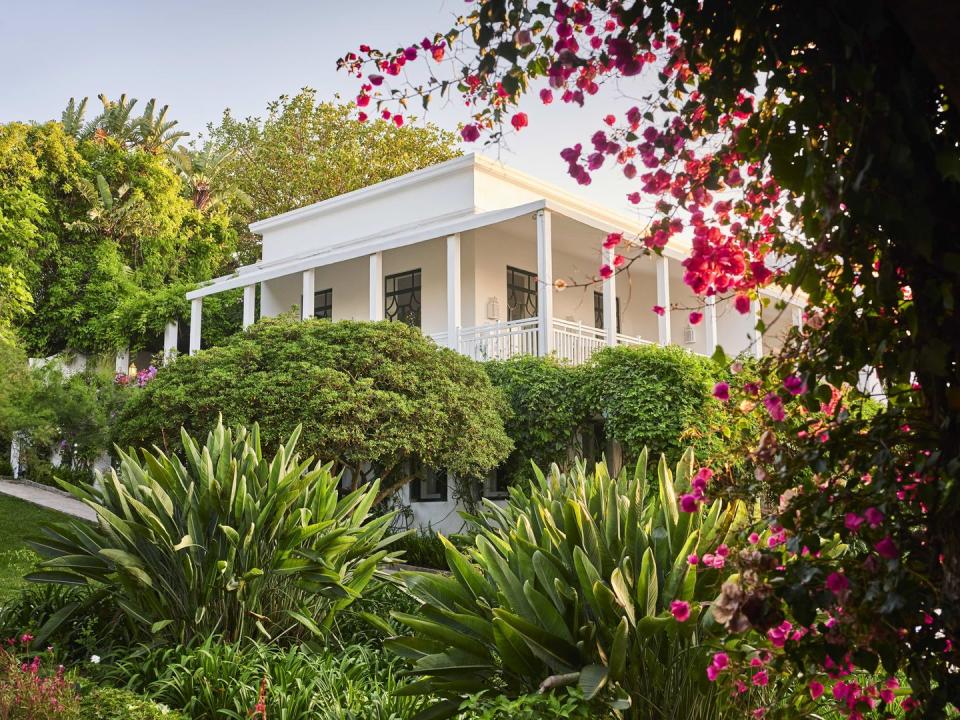
For Villa Mabrouka (meaning ‘blessed’ in Arabic), once the home of legendary couturier Yves Saint Laurent and Pierre Bergé, Conran has transformed the early-20th-century building with a modernist feel into an intimate 12-room hotel surrounded by an oasis of sprawling gardens, pools and terraces with views across the Strait of Gibraltar, marrying Saint Laurent’s original romantic sensibility with his own love for clean, crisp lines and sumptuous textures. ‘It is glamorous in its purity and simplicity, yet comfortable and handsome,’ says the designer, who has his own bedding and bath collection alongside collaborations with brands such as Wedgwood and Next. Against a backdrop of cooling white, the colour palette has verdant greens, hints of ochre, buttercup yellow, cornflower blue and blush pink, with decorative details including 1930s lighting, Mauritanian rugs, handmade bejmat tiles and velvet slipper chairs.
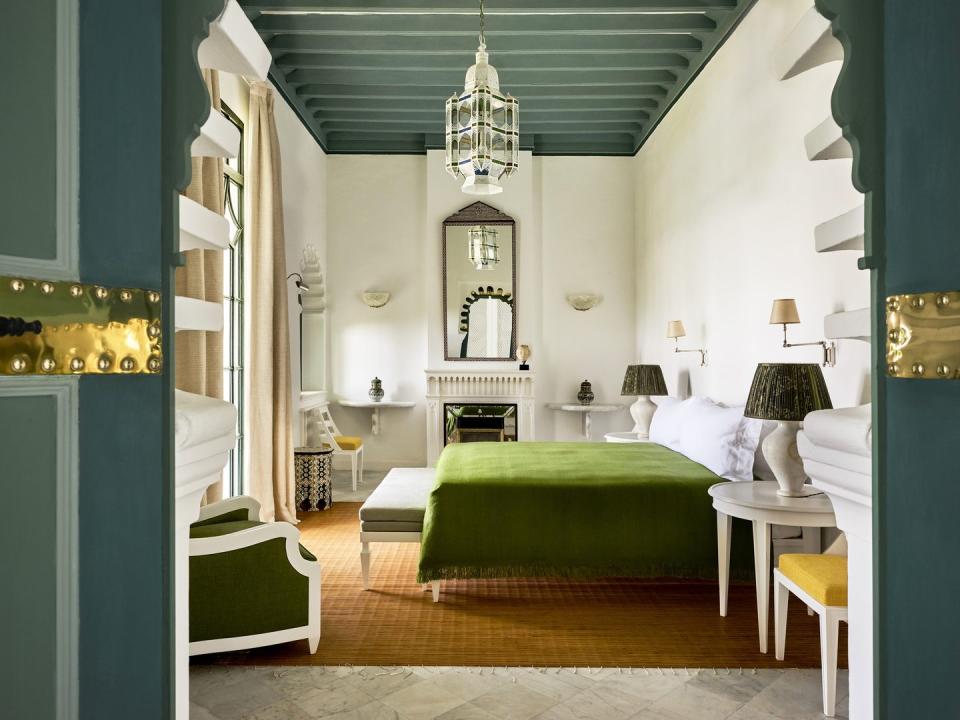
The idea of comfort, says the designer, who has dreamt of being a hotelier ever since he read Ludwig Bemelmans’ book Hotel Splendide as a teen, lies in all the details: the weight and fluffiness of the duvet; how door handles, glasses, cutlery and towels feel in the hand; how your coffee will be served. ‘I imagine things through my own perspective and how it would make me feel. My life has been spent trying to make people feel good about themselves. All these subliminal things, when added up, make staying somewhere unforgettable.’ villamabrouka.com
Portrait Milano, Milan
When Salvatore Ferragamo first arrived in Florence in 1927 and opened his first store in the city a decade later, the shoe designer welcomed Hollywood stars, aristocrats, and international diplomacy with the same sense of Tuscan hospitality as he would have offered in his home. It was an ethos that established the nearly 100 year old brand’s a legacy for made-to-measure hospitality that now extends into the hotel world.
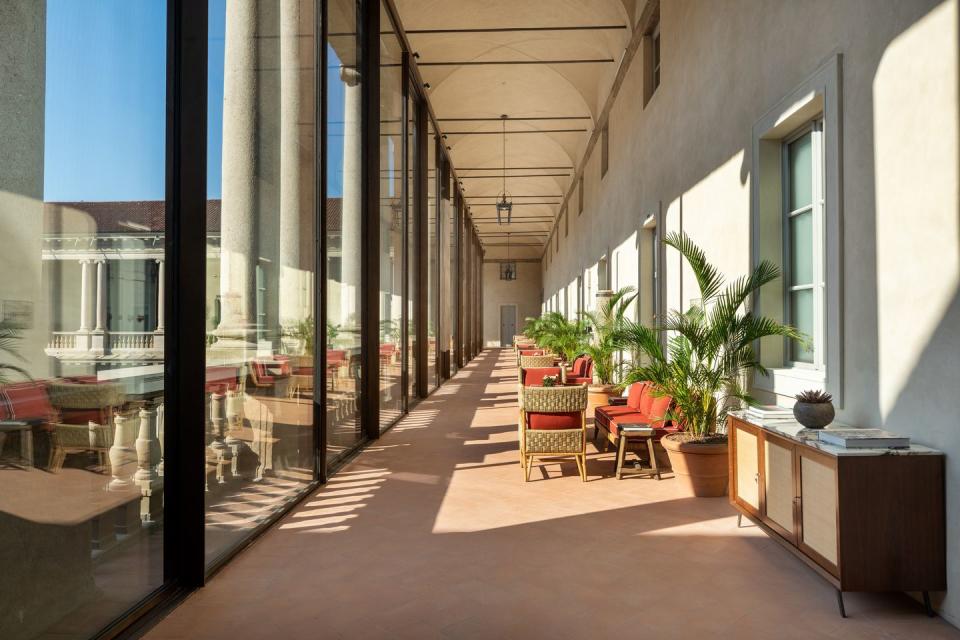
So it’s no wonder then that the Ferragamo’s 73 room Portrait Milano hotel is such a vibrant hub for both the fashion crowd, but also the epicentre for the design world during Salone del Mobile. Located in a former Archiepiscopal Seminary (one of Europe’s oldest) built in the 16th century, tucked right off the heart of Milan’s upmarket Corso Venezia, the building’s restoration – complete with 2,800 sq m piazza – was led by architect Michele De Lucchi with interiors by architect Michele Bönan.
Through the ‘use of precious materials without compromising the functionality of our rooms and common areas,’ says Valeriano Antonioli, CEO of Lungarno Collection, the family’s hospitality arm, Bönan has filled the carpacious spaces, with soaring vaulted ceilings, with a soothing softness and cossetting warmth. Bönan has intertwined an earthy but airy textural palette of ecru linen, grainy woods (from light larch to rich walnut), woven rattan, wrought copper, veined marble, smooth leather and studded wool with jolts of burnt reds, forest greens, turquoise and caramel, stunning sculptural interventions such as a 1950s plaster fractal relief by French sculptor Denis Morog, and the sensuous curves of vintage mid-century armchairs and streamlined modernist lighting.
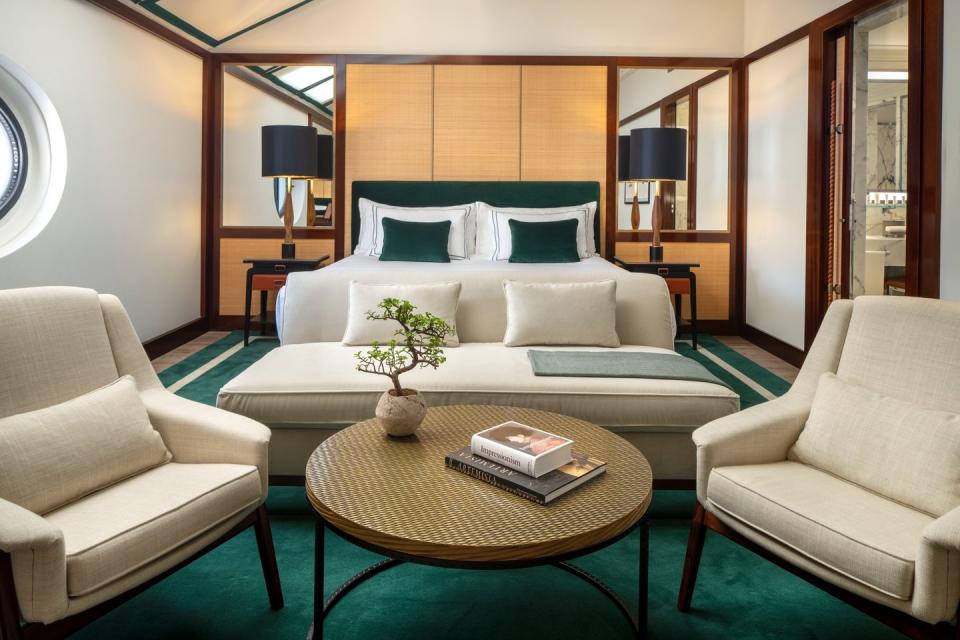
‘While being identified with a recognizable luxury fashion label, the fashion industry is also a volatile one, changing with every season,’ says Antonioli. Whereas a hotel, while needing to remain fashionable, also requires longevity. To do this, the family drew on its core and cultural values to tailor an atmosphere that resonates with ‘the appreciation of true craftsmanship and the intimacy of a home to create places that feel personal and respect where they are located,’ he enthuses.
The Florentine architect Bönan has long collaborated with the Ferragamo family, especially Leonardo Ferragamo, who commissioned his first hotel projects in Florence in the 1990s. Since then, there have been projects all over the world, from New York and Paris to Miami, Monte Carlo and St. Moritz. What Bonan has sensitively created at the Portrait Milano, asserts Antonioli, is ‘an atmosphere through the mosaic of a million details that coexist in complete harmony, where the human touch is a natural expression of the Italian way of being hospitable.’ lugarnocollection.com
Belmond La Residencia, Deià
When Matthew Williamson swapped the world of catwalks and London life for the small coastal island of Deià, in northeastern Mallorca, he threw himself into interior design. Not only in creating a new home for himself and his family, but also for Suite No 67 at the hotel Belmond La Residencia nearby. ‘I fell in love with Deià from the moment I first visited. It’s one of the places where I feel most creative, so it was just such a natural and wonderful starting point for the whole hotel-suite concept,’ says Williamson.
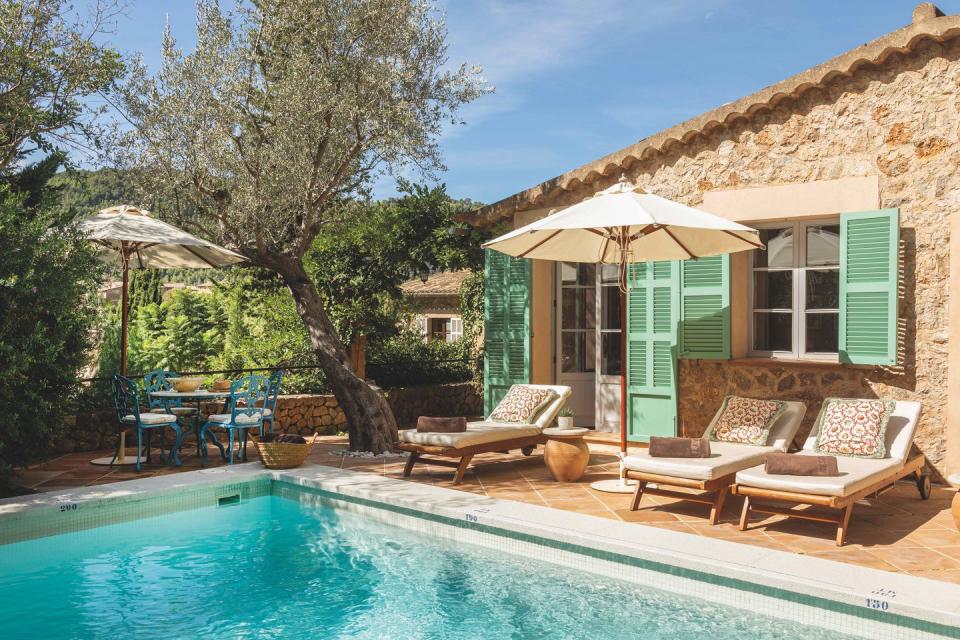
Gathering the details that make the space so special – think hand-painted ceramic entrance floor tiles by Balineum and framed botanical works from John Derian that reflect the island’s wild, lush flora and foliage – was, says Williamson, ‘a real labour of love’, with each piece being chosen for its exceptional craftsmanship.
Unique and full of personality, the suite has the feeling of a private house set within a hotel. Nothing about it is generic; from the bedroom to the bathroom, living area and poolside garden terrace (surrounded by olive trees and picturesque views of the Serra de Tramuntana mountains), it feels like stepping into a particularly fantastic friend’s space. The effect is thanks in no small part to Williamson’s kaleidoscopic use of electric colour and wild pattern, which are splashed across upholstery, walls and floors. Those in the know will spot his own fabric and wallpaper designs for Osborne & Little, his love for lighting adorned with ostrich feathers, as well as locally sourced ceramics, art, brightly painted furniture and handmade Portuguese ceramic lamps with block-printed shades.
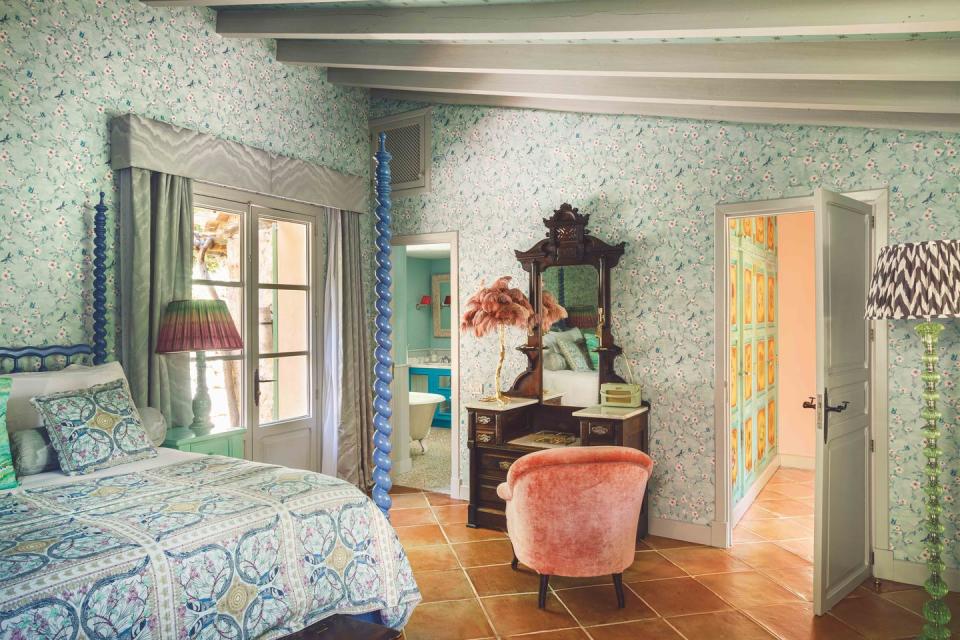
A suite unlike any other, it fits perfectly with Belmond La Residencia’s vibe as an artistic hub in the mountain village – the hotel boasts the largest display of Miró paintings to be seen anywhere in the world. ‘Stopping fashion and moving into interiors felt like a genuine progression,’ enthuses Williamson, who, after dipping his toe into hospitality, has gone on to spread his style further thanks to collaborations with the likes of John Lewis & Partners. ‘I’m simply continuing what I established as a fashion designer and expressing it in a new form.’ belmond.com
Le Grand Mazarin, Paris
Tucked away in a Le Marais side street, Le Grand Mazarin’s smart lipstick-red façade is just the first hint of the explosion of colourful pattern and chic French salon style of its Martin Brudnizki-designed interiors. ‘Just like fashion, hospitality is very much about the details,’ says Kimberley Cohen, co-founder and artistic director of luxury-hotel brand Maisons Pariente, established with her father Patrick Pariente (co-founder of French fashion brand Naf Naf) and her sister, Leslie Kouhana.
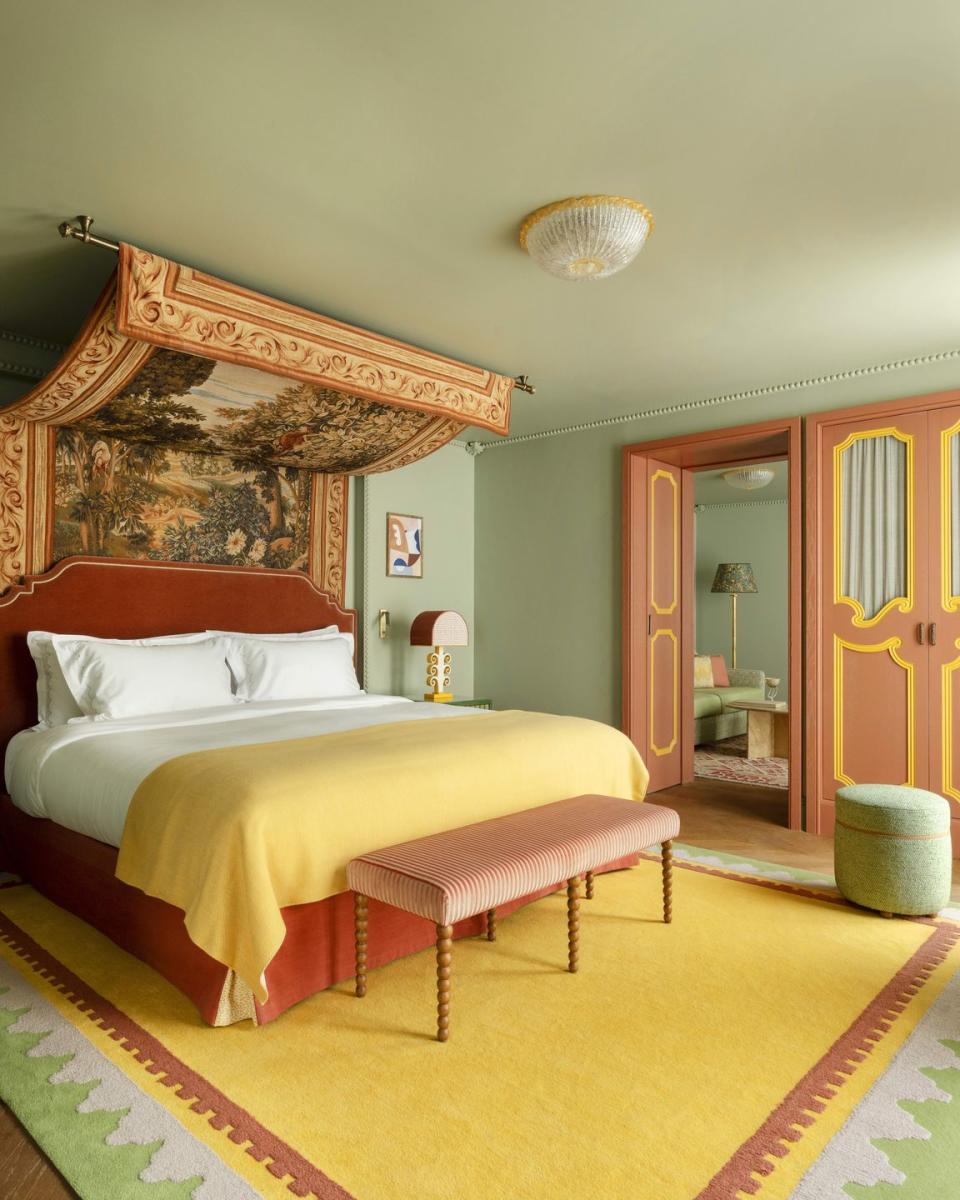
‘Everything has to be taken into consideration, from the sense of arrival, the smell, the music, the softness, the amenities, the choice of the spa brand. It is an entire experience,’ she says. ‘There is also the idea of belonging. When you stay in a hotel, you need to feel you are exactly where you should be.’ The fundamental difference between running a hotel (the Maison Pariente group also includes Lou Pinet in Saint-Tropez, Le Coucou in Méribel and Crillon le Brave in Provence) and a fashion brand, which you can update every season, is that ‘the decoration of a hotel needs to be timeless, because you can’t reinvent yourself every six months,’ says Cohen of the 50-room, 11-suite hotel with the prettiest swimming pool (its whimsical Jean Cocteau-inspired vaulted ceiling was painted by Paris-based visual artist Jacques Merle).
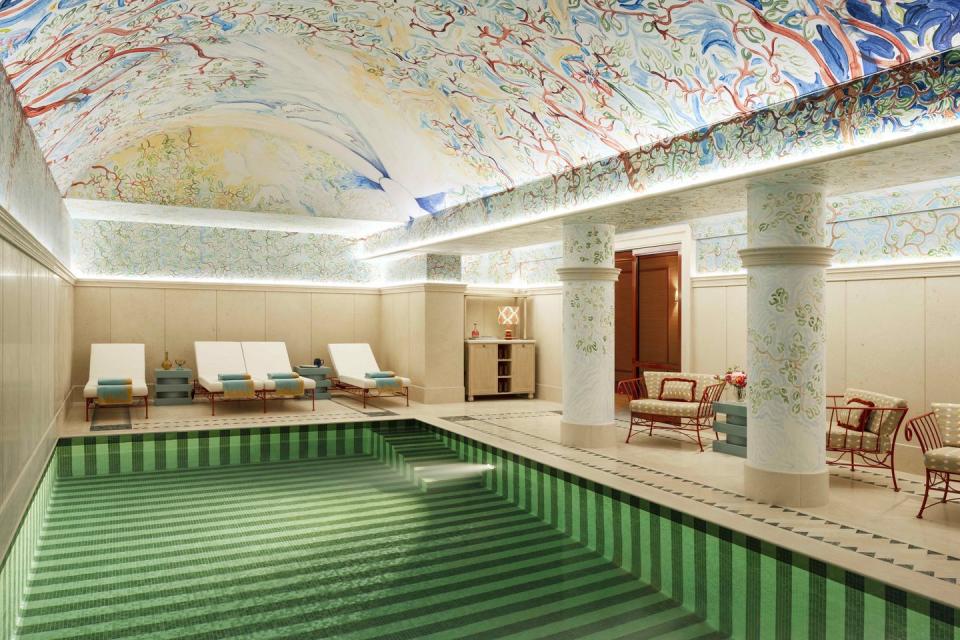
Her history, immersed in the legacy of the success of playful brand Naf Naf – which the family sold in 2006 – means an eternal respect for ‘the devil in the detail,’ says Cohen. ‘You can have the best decoration, but if you have the wrong pillow and a guest has a bad night it affects their whole experience of the hotel.’ Walls, floors, ceilings, bathroom tiles, bed throws and furniture are washed in seductive sherbet shades such as apricot and pistachio, and every space has been finessed to chime with the area’s bohemian vibe, with over 2,000 pieces of curated art, objets d’art, 18th-century-style tapestry-bed canopies and original trompe l’œil frescoes by Menorca-based artist Sofia Pega. The idea, says Cohen, is to ‘create a journey of imagination and discovery’. legrandmazarin.com


